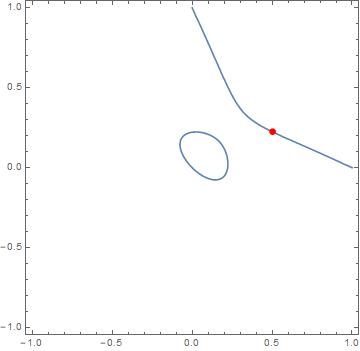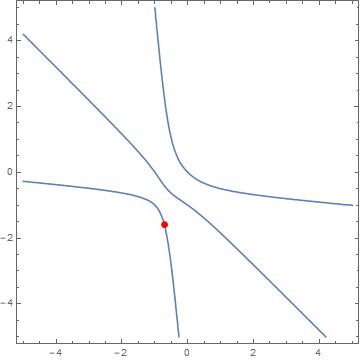I am reading a preprint and I do not quite follow a seemingly known fact:
Let $E$ be an elliptic curve on the real projective plane with two real components. Let $O\subset E$ the oval component (apologies to the elliptic curve "groupies", I couldn't think of a better symbol. The authors also use $O$). Then the paper says that if we apply a Cremona transformation with three base points on the projective plane such that $O$ has one or three base points and $E\backslash O$ has the remaining base points, then the oval will transform into a non-oval and vice versa. I do not immediately see this. I have tried to compute this with particular elliptic curves and this is indeed true. But why is this true in general?
Below is the Mathematica code I use to investigate this :
Remove@"Global`*"
totalDeg:=Exponent[# /. ((# -> \[FormalX] RandomReal[]) & /@ Variables[#]), \[FormalX]] &;
homogenize[f_,z_,vars_]:= z^totalDeg[f]*Expand[f /. ((#->#/z)&/@vars)]//Expand;
homogenize[f_,z_] := homogenize[f,z,Variables[f]];
(*Cremona with 1 base points on oval and 2 on non-oval*)
f = x(x-1)(x-2);
f = f /. {x -> 3*Sqrt[2] x};
f = f/12 - y^2;
f=f/.{x->1/Sqrt[2]x+1/Sqrt[2]y,y->1/Sqrt[2]x-1/Sqrt[2]y};
F = homogenize[f,w]
cp = ContourPlot[f==0,{x,-1,1},{y,-1,1}];
sol = NSolve[{f==0,x==0.5},Reals];
pt ={x,y}/.sol[[1]];
gpt = Graphics[{Red, PointSize[0.01], Point[pt]}];
Show[cp,gpt]
G = F/.{w->1/(w+x+y)+1/x+1/y, x->1/x, y->1/y}
G = Numerator@Together@G
g = G/.{w->1}
pt = {w,x,y}/.{w->1/(w-x-y)-1/x-1/y, x->1/x, y->1/y};
pt = pt/.{w->1};
pt = pt/.sol[[1]];
pt = pt/pt[[1]];
pt = pt[[2;;3]]
gpt = Graphics[{Red, PointSize[0.01], Point[pt]}];
cp = ContourPlot[g-0.01==0,{x,-3,3},{y,-3,3}];
Show[cp,gpt]
(*Cremona with 3 base points on oval and 0 on non-oval*)
f = x(x-2)(x-3);
f = f /. {x -> Sqrt[2] x};
f = f/4 - y^2;
f=f/.{x->1/Sqrt[2]x+1/Sqrt[2]y,y->1/Sqrt[2]x-1/Sqrt[2]y};
F = homogenize[f,w]
cp = ContourPlot[f==0,{x,-1,1},{y,-1,1}];
sol = NSolve[{f==0,x==0.5},Reals];
pt ={x,y}/.sol[[1]];
gpt = Graphics[{Red, PointSize[0.01], Point[pt]}];
Show[cp,gpt]
G = F/.{w->1/(w+x+y)+1/x+1/y, x->1/x, y->1/y}
G = Numerator@Together@G
g = G/.{w->1}
pt = {w,x,y}/.{w->1/(w-x-y)-1/x-1/y, x->1/x, y->1/y};
pt = pt/.{w->1};
pt = pt/.sol[[1]];
pt = pt/pt[[1]];
pt = pt[[2;;3]]
gpt = Graphics[{Red, PointSize[0.01], Point[pt]}];
cp = ContourPlot[g==0,{x,-1.5,1.5},{y,-1.5,1.5}];
Show[cp,gpt]
Below are the figure showing that the oval changes to non-oval and vice versa (I marked a point on one component and its image with red dots to know what is changed). My base points are $(0,0),(1,0)$ and $(0,1)$ on the affine plane.
Cremona transformation from one base point on the oval and two base points on the non-oval.


Cremona transformation from three base points on the oval and no base point on the non-oval.


